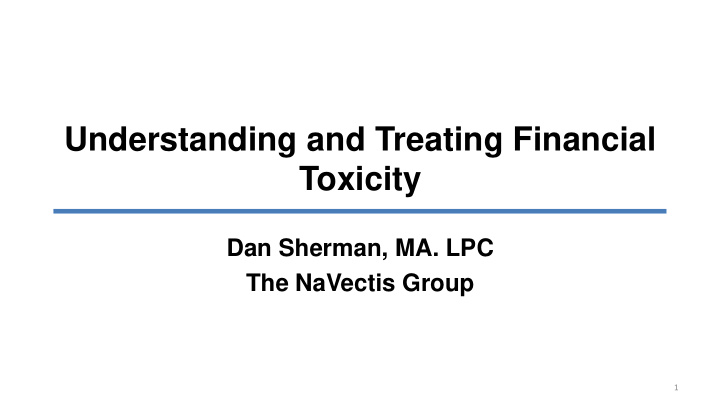



Understanding and Treating Financial Toxicity Dan Sherman, MA. LPC The NaVectis Group 1
Financial Toxicity Through the lens of a person facing cancer
What is Financial Toxicity? The term financial toxicity is broadly used to describe the distress or hardship arising from the financial burden of cancer treatment . In much the same way as physical side-effects of treatment like fatigue, nausea or blood toxicities, financial problems after cancer diagnosis are a major contributor higher levels of stress , poorer quality of life , treatment non-adherence and delayed medical care .
Financial Toxicity: Multi-Faceted Impacts A survey of breast cancer 27% of adult insured patients found that 94% of this cancer patients population wanted to discuss cost of treatment but only 14% of reported medication them reported having that non-adherence due to conversation Journal of Community and Supportive cost J of Oncology Practice 2019 Oncology, 2016. Cancer patients demonstrate more anxiety over the cost of treatment than over dying from their disease Oncology Times, August 2009 A 2015 study found that there is a Benchmark Employer direct correlation between Survey Finds Average Cancer Related Financial Burden Family Premiums Now and qualify of life . Higher CRFB Top $20,000 Kaiser Family Foundation scores correlates to lower Qualify 2019 of Life scores. The Oncologist 2015
Maslow’s Hierarchy of Needs Interpersonal relationships Ability to keep health coverage Financial Security Food, shelter, transportation Health
The Oncology Care Model (OCM) and the IOM Care Management Plan 1. Diagnosis 2. Prognosis 3. Treatment Goals 4. Treatment Duration 5. Expected Response 6. Treatment Benefits/Harm 7. Quality of Life 8. Advanced Care Planning 9. Estimated Cost 10. Plan to address psychosocial need 11. Survivorship Plan
Models of Financial Advocacy Programs Financial Counselors o Medicaid Enrollment o Charity Programs Social Worker/Financial Advocate o Co-Pay and PAP Assistance o Basic Needs Financial Navigation o Insurance Optimization o Part of Multidisciplinary Team o Involved with Treatment Plan o Navigates our complex health insurance landscape
Financial Navigation Treating financial toxicity by proactively guiding patients through our complex healthcare system to help them gain access to care by reducing financial barriers . o Insurance Optimization o Proactive Engagement o External Assistance Optimization o A part of the Multi-Disciplinary Team o Advocate for the Patient
Financial Navigator Required Knowledge Base Government Safety Net Programs Health Insurance Policies External Assistance Programs Disease Knowledge & Treatment Process *Logos are meant to illustrative not exhaustive of all options
Financial Navigation A Central Part of of the Multi-Disciplinary Team Optimizing Incorporating Coverage / the clinical External needs of the Assistance patient Programs Benefit Direct access Investigation, to billing Financial Prior department Navigation Authorization Services
Patient Financial Responsibility Example BEFORE Insurance Optimization 5 Start Patient Protection and Affordable Care Act
Patient Financial Responsibility Example AFTER Insurance Optimization
The Complexities of Medicare Coverage 50% of Medicare beneficiaries fall below 200% of FPL. KFF 2014
Case Study A 67-year-old married male diagnosis with Metastatic Melanoma. Monthly household gross income is $1,680 and they have $11,000 in assets. He has Medicare A and B only. He is not enrolled in part D. It is March 2018. Treatment regimen included surgery followed by biologic therapies. Total treatment cost for one year estimated to be around $380,000 Patient responsibility estimated to be around $44,000
Financial Navigation Intervention Optimizing Insurance Coverage o Low Income Subsidy (LIS) o Medicare intervention (Medigap vs. MAPD) Optimizing External Assistance Programs o Co-Pay Assistance Foundation $6,000 o Premium Assistance $2,400 o MSP $3,252 Estimated Savings to the Patient $47,000 Estimated Savings to the Provider $44,000
Part D Coverage Structure Initial coverage $3,820 (4,020 in 2020) Donut hole $5,100 ($6,350 in 2020) Catastrophic Coverage 5% o Below 150% of FPL o Assets below $14,390 single / $28,720 married
` Without Low Income Subsidy (LIS)
` With Low Income Subsidy (LIS)
Optimizing External Assistance Programs o Manufacturer Patient Assistance Programs o Co-Pay Assistance Programs o Premium Assistance Programs o Patient Financial Support Programs o Software platforms o AssistPoint o TailorMed o Vivor
Retroactive Opportunities to Decrease Financial Toxicity
Training opportunities o ACCC Financial Advocacy Bootcamp o Local SHIP o Triage Cancer o NaVectis Financial Navigation Training Program o On site classroom style training o 12-24 months of remote support o Tracking software
Financial Navigation Helps Decrease Financial Toxicity
Financial Navigation Can Support: o Improved access to care o Reduction of financial toxicity o Reduction in bad debt/charity o Increased Patient Satisfaction Scores o Reduction in stress / workload for the Social work department o Significant ROI for provider
Thank you Contact Information: Dan Sherman, MA, LPC DSherman@NaVectis.COM 616-818-6583
Recommend
More recommend